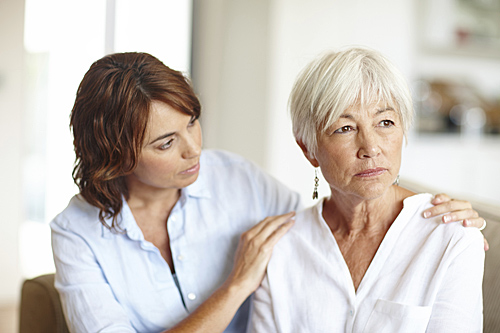Talking With Your Loved One About Incontinence

Seniors who are experiencing urinary incontinence often feel all alone. But they are not. Though the topic seldom comes up in conversation, incontinence affects more than half of women past the age of menopause, and also affects many senior men. According to the American College of Physicians (ACP), over $20 billion per year is spent on incontinence, and it accounts for 6 percent of nursing home admissions.
Family caregivers are often the ones to notice that an elder loved one is experiencing incontinence—yet many family members report that their loved one avoids discussing the problem. But this is a genuine health issue that needs to be addressed promptly. Incontinence causes skin irritation, interferes with sleep, and can lead to depression. As seniors worry about having an “accident,” they begin to stick close to home, leading to a debilitating decline in social connectedness, physical activity and intellectual stimulation. This can lead to a dangerous cycle. For example, Dr. JoAnne Pinkerton, Executive Director of the North American Menopause Society, reports on the relationship between incontinence and osteoporosis. Said Dr. Pinkerton, “Many women with incontinence find themselves limiting physical activity out of fears of leakage.”
Incontinence seldom gets better without medical treatment. Yet the National Association for Continence estimates that the average senior waits close to seven years to report the problem to their doctor. The ACP said that women, in particular, often remain silent. Said ACP president Dr. David Fleming, “Urinary incontinence is a common problem for women that is often underreported and underdiagnosed. Physicians should take an active approach and ask specific questions such as onset, symptoms, and frequency of urinary incontinence; it is estimated that about half of the women with incontinence do not report it to their doctor.”
What Causes Urinary Incontinence?
As is true with any health condition, the first step in treating incontinence is to determine underlying causes. It’s important to diagnose the type or combination of types of incontinence the person is experiencing.
Urge incontinence results from neurological damage, strokes, diabetes or the aftermath of bladder infections or kidney stones. In this circumstance, the individual does not receive a signal in time to reach the bathroom before the bladder begins to empty itself.
Overflow incontinence occurs when small amounts of urine leak from a bladder that is always full due to conditions such as obstruction, constipation or nerve damage. In men, enlarged prostate is often the cause.
Stress incontinence means the involuntary passing of urine during any increase in abdominal pressure, such as coughing, sneezing, laughing or lifting heavy objects. It is caused by weakened pelvic muscles.
Functional incontinence occurs when a person has normal bladder control, but is unable to get to the toilet on time because of a mobility problem or dementia.
Depending on the underlying cause or causes of a person’s incontinence, the doctor may recommend:
Lifestyle changes, such as cutting down or eliminating caffeine, alcohol and tobacco products or some medications, all of which can irritate the bladder.
Bladder training, which builds a patient’s ability to hold urine for longer periods.
Pelvic muscle exercises to strengthen the bladder muscles and the muscles of the pelvic floor.
Medications targeted to treating the type of incontinence the patient is experiencing.
Medical devices to help prevent leaking or to hold the bladder in place.
Surgery, which is sometimes recommended when other treatments are ineffective.
Treating underlying medical conditions, such as urinary tract infections, obesity and osteoporosis.
Many people with incontinence feel more secure wearing special absorbent, disposable undergarments which are inconspicuous and quite effective at masking the incontinence. These undergarments are sold in drugstores and supermarkets and can enhance the person’s peace of mind.
Providing Help While Preserving Your Loved One’s Dignity
Family members are urged to reassure their loved ones and to encourage them to seek help. Use tact and sensitivity when discussing this issue with your loved one. Try not to overreact if an older family member or friend has an accident around you. This is one of those occasions in which you need to be particularly careful in your caring! The first step might be to share with your loved one that they are in good company with millions of other people who are taking charge of incontinence. If your loved one agrees, come along to a healthcare appointment and talk to the doctor about ways you can help—which might even be as simple as cleaning up clutter so your loved one can make it to the bathroom on time. Even though this can be an embarrassing problem, it’s nice not to feel alone while addressing it.
Learn More
The National Institutes of Health’s SeniorHealth website offers in-depth information for consumers about the diagnosis and treatment of incontinence.
Source: IlluminAge AgeWise
![Health Concepts [logo]](https://healthconceptsltd.com/wp-content/themes/healthconcepts-corporate/images/logo.png)
